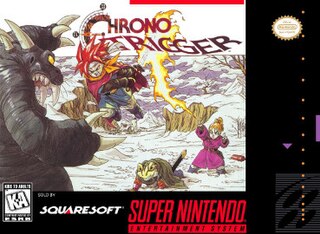
Chrono Trigger is a 1995 role-playing video game developed and published by Square. It was originally released for the Super Nintendo Entertainment System as the first entry in the Chrono series. The game's development team included three designers that Square dubbed the "Dream Team": Hironobu Sakaguchi, creator of Square's Final Fantasy series; Yuji Horii, creator of Enix's Dragon Quest series; and Akira Toriyama, character designer of Dragon Quest and author of the Dragon Ball manga series. In addition, Takashi Tokita co-directed the game and co-wrote the scenario, Kazuhiko Aoki produced the game, while Masato Kato wrote most of the story. The game's plot follows a group of adventurers who travel through time to prevent a global catastrophe.
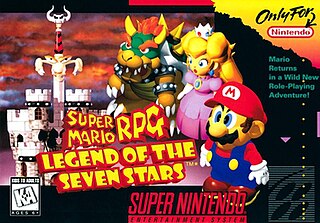
Super Mario RPG: Legend of the Seven Stars is a 1996 role-playing game developed by Square and published by Nintendo for the Super Nintendo Entertainment System (SNES). It was the final Mario game published for the SNES. The game was directed by Chihiro Fujioka and Yoshihiko Maekawa, produced by Shigeru Miyamoto, and scored by Yoko Shimomura.
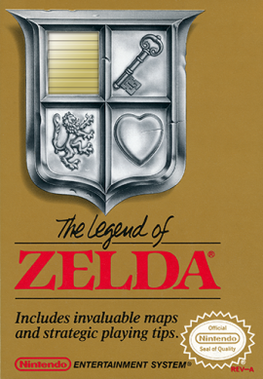
The Legend of Zelda, originally released in Japan as The Hyrule Fantasy: Zelda no Densetsu, is an action-adventure game developed and published by Nintendo. The first game of The Legend of Zelda series, it is set in the fantasy land of Hyrule and centers on an elf-like boy named Link, who aims to collect the eight fragments of the Triforce of Wisdom in order to rescue Princess Zelda from Ganon. The player controls Link from a top-down perspective and navigates throughout the overworld and dungeons, collecting weapons, defeating enemies and uncovering secrets along the way.
Dragon Quest, previously published as Dragon Warrior in North America until 2005, is a series of role-playing games created by Japanese game designers Armor Project, Bird Studio and Sugiyama Kobo to its publisher Enix, with all of the involved parties co-owning the copyright of the series since then. The games are published by Square Enix since its inception, with localized remakes and ports of later installments for the Nintendo DS, Nintendo 3DS, and Nintendo Switch being published by Nintendo outside of Japan. With its first game published in 1986, there are eleven main-series games, along with numerous spin-off games. In addition, there have been numerous manga, anime and novels published under the franchise, with nearly every game in the main series having a related adaptation.

A role-playing video game, commonly referred to as a role-playing game (RPG) or computer role-playing game (CRPG), is a video game genre where the player controls the actions of a character immersed in some well-defined world, usually involving some form of character development by way of recording statistics. Many role-playing video games have origins in tabletop role-playing games and use much of the same terminology, settings, and game mechanics. Other major similarities with pen-and-paper games include developed story-telling and narrative elements, player character development, complexity, as well as replay value and immersion. The electronic medium removes the necessity for a gamemaster and increases combat resolution speed. RPGs have evolved from simple text-based console-window games into visually rich 3D experiences.
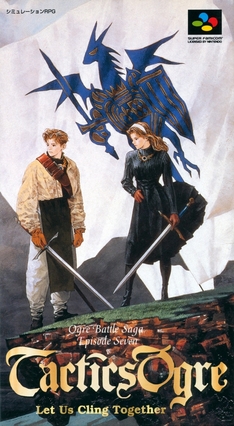
Tactics Ogre: Let Us Cling Together is a 1995 tactical role-playing game developed and published by Quest Corporation for the Super Famicom. It was later ported to the Sega Saturn (1996) and the PlayStation (1997), the latter released in North America in 1998 by Atlus USA. The second entry in the Ogre Battle series, the story takes place in the war-torn kingdom of Valeria, where protagonist Denim Powell works in a local resistance force against occupying powers, ending up caught in the ethnic conflicts driving the war. Battles are turn-based, taking place on grid-based maps from an overhead perspective with a focus on positioning and using character class abilities.

Itadaki Street is a party video game series originally created by Dragon Quest designer Yuji Horii. It is currently owned by Square Enix. The first game was released in Japan on Nintendo's Famicom console in 1991. Since then, new installments in the series have been released for the Super Famicom, PlayStation, PlayStation 2, PlayStation Portable, Nintendo DS, Mobile Phones, Android, iOS, PlayStation 4 and PlayStation Vita. The series was exclusive to Japan prior to the 2011 Itadaki Street Wii, which is released as Fortune Street in North America and Boom Street in Europe.

Dragon Quest II: Luminaries of the Legendary Line, titled Dragon Warrior II when initially localized to North America, is a role-playing video game developed by Chunsoft and published by Enix in 1987 for the Nintendo Entertainment System as a part of the Dragon Quest series. Enix's U.S. subsidiary published the American release, Dragon Warrior II, for the Nintendo Entertainment System in 1990. Dragon Quest II is set one hundred years after the events of the first game.
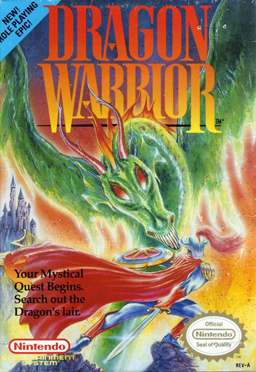
Dragon Quest, titled Dragon Warrior when initially localized to North America, is a role-playing video game developed by Chunsoft and published by Enix for the Nintendo Entertainment System. It was originally released in Japan in 1986 and by Nintendo in North America in 1989. It is the first game in the Dragon Quest video game series. Dragon Quest has been ported and remade for several video game platforms, including the MSX, MSX2, PC-9801, Super Famicom, Game Boy Color, mobile phones, and Nintendo Switch as of 2019. The player controls the hero character who is charged with saving the Kingdom of Alefgard and rescuing its princess from the evil Dragonlord. Dragon Warrior's story became the second part in a trilogy, with several spinoff anime and manga series.
Noriko Matsueda is a Japanese former video game composer. She is best known for her work on the Front Mission series, The Bouncer, and Final Fantasy X-2. Matsueda collaborated with fellow composer Takahito Eguchi on several games. Composing music at an early age, she began studying the piano and electronic organ when she was three years old. She graduated from the Tokyo Conservatoire Shobi, where she met Eguchi.
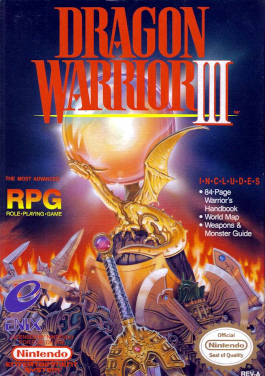
Dragon Quest III: The Seeds of Salvation, titled Dragon Warrior III when initially localized to North America, is a 1988 role-playing video game developed by Chunsoft and published by Enix. It is the third installment in the Dragon Quest series and was first released for the Family Computer (Famicom) in Japan and later for the Nintendo Entertainment System (NES) in North America. The game saw an enhanced remake for the Super Famicom in 1996 and the Game Boy Color in 2001, and a port to mobile phones and the Wii in 2009 and 2011. A version of the game for Android and iOS was released in Japan on September 25, 2014, and worldwide as Dragon Quest III: The Seeds of Salvation on December 4, 2014. It was the first time the game was given an official English subtitle. Later in 2021, another remake of the game titled Dragon Quest III HD-2D Remake, based on Octopath Traveler's style, was announced during the franchise's 35th anniversary livestream.
Tactical role-playing games, also known as strategy role-playing games and in Japan as simulation RPGs, are a video game genre that combines core elements of role-playing video games with those of tactical strategy video games. The formats of tactical RPGs are much like traditional tabletop role-playing games and strategy games in appearance, pacing, and rule structure. Likewise, early tabletop role-playing games are descended from skirmish wargames such as Chainmail, which were primarily concerned with combat.

Treasure Hunter G is 1996 a turn-based tactical role-playing game developed by Sting Entertainment and published by Square exclusively for the Super Famicom, and in Japan.

Akitoshi Kawazu is a Japanese game designer, director, producer and writer. After joining Square in 1985, he went on to become a central developer for the first two Final Fantasy titles, then acted as creator and lead developer for the SaGa series.
Kazushige Nojima is a Japanese video game writer. He is best known for writing several installments of Square Enix's Final Fantasy franchise—namely Final Fantasy VII and its spin-offs Advent Children and Crisis Core, Final Fantasy VIII, and Final Fantasy X and X-2—in addition to the Kingdom Hearts series, the Glory of Heracles series, and the story to the Subspace Emissary mode in Super Smash Bros. Brawl. Nojima also wrote the original lyrics of "Liberi Fatali" for Final Fantasy VIII and both "Suteki da Ne" and the "Hymn of the Fayth" for Final Fantasy X, as well as "No Promises to Keep" for Final Fantasy VII Rebirth. He is also the founder of Stellavista Ltd.
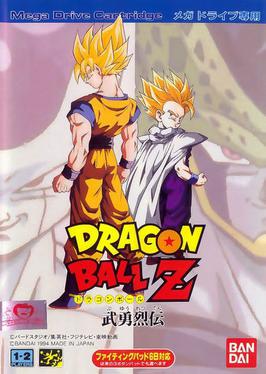
Dragon Ball Z: Buyū Retsuden is a 1994 fighting video game developed and published by Bandai and Ecofilmes for the Sega Mega Drive. Based upon Akira Toriyama's Dragon Ball franchise, it is the only game in the series released for the Mega Drive, following the Frieza and Cell sagas. Its gameplay has been described as a combination of the original Super Butōden and Super Butōden 2, consisting of one-on-one fights using a three-button configuration, featuring special moves and two playable modes.

Blood of Bahamut is an action role-playing video game developed by Think & Feel and published by Square Enix. It was released for the Nintendo DS in Japan on August 6, 2009.
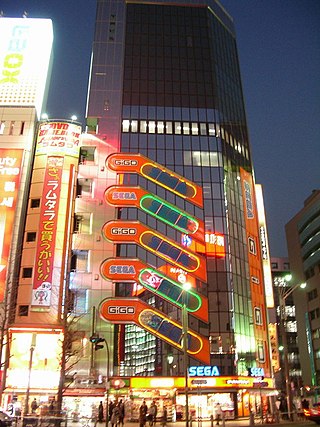
Video games are a major industry in Japan, and the country is considered one of the most influential in video gaming. Japanese game development is often identified with the golden age of video games and the country is home to many notable video game companies such as Nintendo, Sega, Taito, Bandai Namco Entertainment, Capcom, Square Enix, Konami, NEC, SNK and formerly Sony Computer Entertainment. Japan is currently the third largest video game market in the world after China and the United States.
The Turbo File devices from ASCII Corporation are external storage devices for saved game data on various Nintendo consoles. They have been sold only in Japan, and are mainly supported by ASCII's own games. The first one was designed primarily to allow players transfer data between the Wizardry games released on the Famicom.
While the early history and distinctive traits of role-playing video games (RPGs) in East Asia have come from Japan, many video games have also arisen in China, developed in South Korea, and Taiwan.














